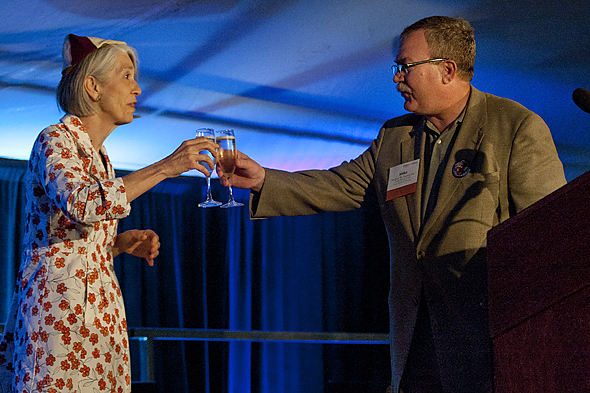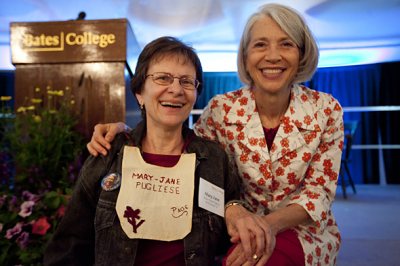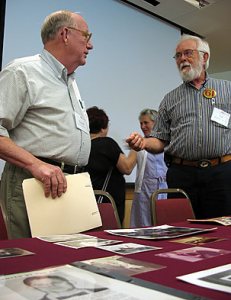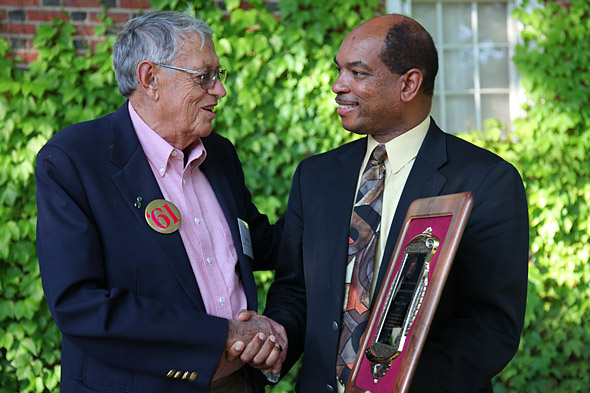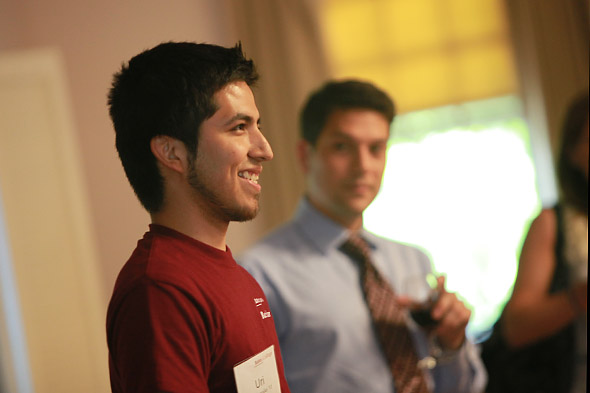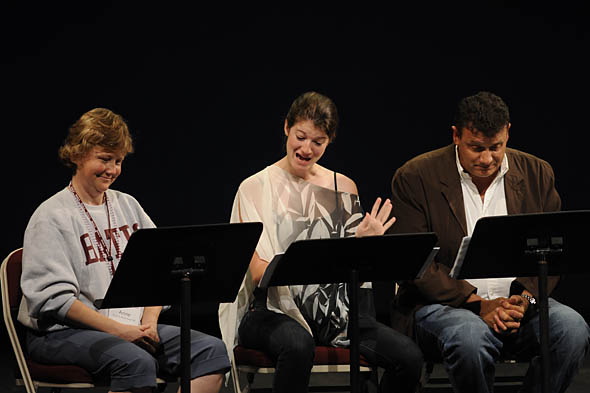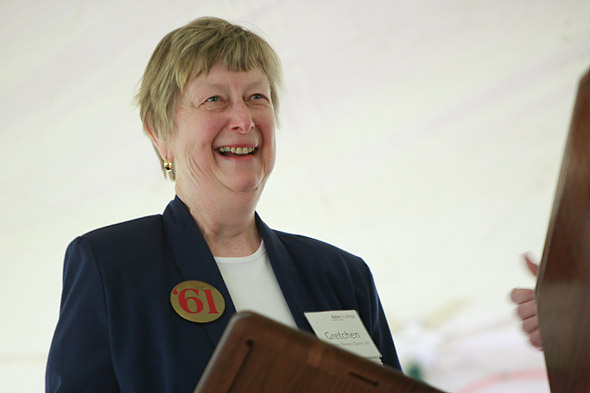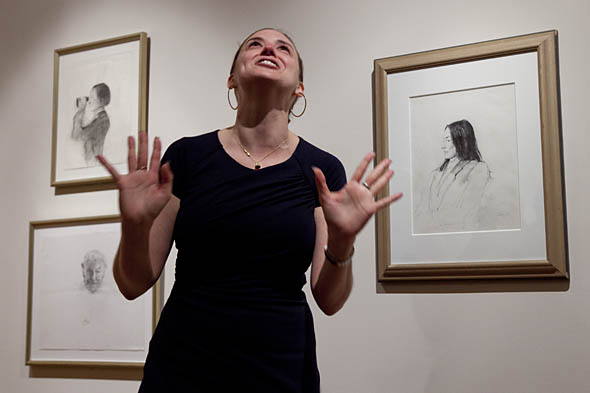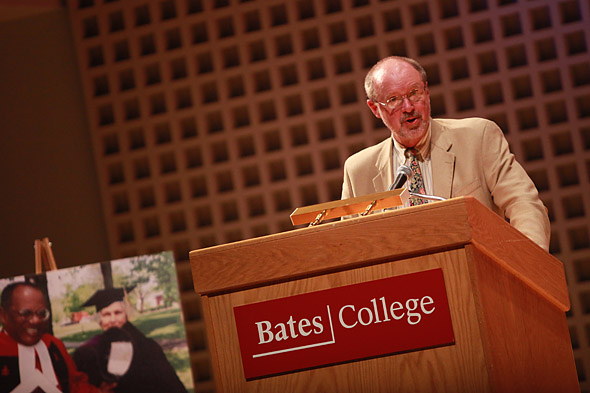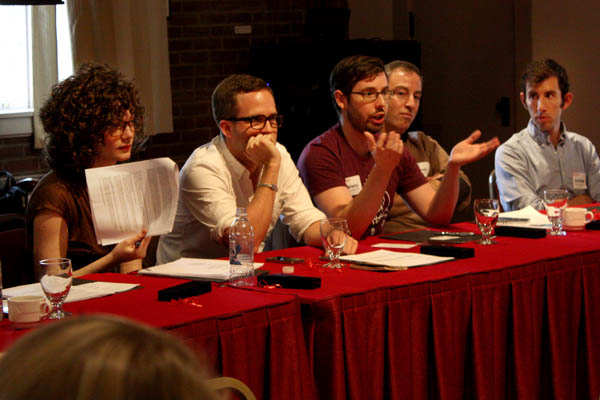
Reunion 2011
With Reunion 2011 now in the books, here’s a tour of the weekend, in words, by Bates Magazine editor Jay Burns and college writer Doug Hubley.
Presidential party
As Friday evening’s tribute to outgoing President Elaine Tuttle Hansen got going, Nancy Cable, who will become interim president in July, offered one programming note, promising everyone that the tribute would conclude in time for the Bruins game. Big cheers.
Cable, who is vice president and dean of enrollment and external affairs, was joined by Chairman of the Board Mike Bonney ’80.
Bonney and Hansen share a certain kinship. Both became leaders of their institutions around the same time, Hansen at Bates in 2002 and Bonney as CEO of Cubist in 2003. From that perspective, Bonney said that watching Hansen’s presidency made him a better CEO.
“I learned how to balance various constituencies,” he said. “I learned how to be persistent in a quiet and clear way. And I learned that an institution must take steps today to prepare for what happens tomorrow.”
Bonney specifically pointed to Hansen’s bold action early in her presidency, when she asked Bates to pause its plan to build a full-scale campus center. Instead, she directed Bates to undertake a Campus Facilities Master Plan, which yielded bountiful intelligence about Bates facilities needs, including the stronger need for a new dining facility.
Hansen called the achievements during her presidency “a group project. This is not about one person. This is about what people do when they collaborate.”
Extending the kudos, she said that active engagement “is all about what Bates people do. It’s what you do in your communities when you demonstrate the values you learned at Bates.”
Hansen, Bonney and Cable each wore a beanie, the kind that male freshmen had to wear each fall until about 1970.
Batesies being aware of historical accuracy, party attendee Mary-Jane Pugliese Robichaud ’67 not only suggested, nicely, that Hansen should have worn a bib (the women’s version of the beanie, onto which they embroidered their names) but she also proudly showed Hansen her own circa 1963 bib.
Kidnapping and bombings
“The work was good,” said retired FBI agent Dave Jellison ’61, recalling a stint in Steubenville, Ohio. “Organized crime, kidnapping, bombings and white slavery.”
Equating good work with a few heinous crime elicited laughs from Jellison’s audience, but also gave a bit of insight into the ebb and flow of a G-man’s life in the early 1960s.
Jellison was one of several 1961 alums who shared tales from careers, hobbies, and other pursuits as part of the traditional 50th Reunion Seminar program.
Before being assigned to Steubenville’s mean streets, Jellison worked in Miami, where he was assigned to the “barbecue squad,” doing surveillance of cookouts and other social gatherings involving the KKK or civil rights groups.
In Miami, Jellison worked with a criminal informant. The guy had burned down a couple jai alai frontons, among other things, and once used broom wire to tie a prison guard’s hands to the jail cell bars. He finally wore out his welcome among the bad guys and turned informant, helping Jellison and the feds get convictions in all 14 of the criminal cases in which he testified.
The informant later went into witness protection. In his new community, he so ingratiated himself with the town fathers that they asked him to become their chief of police. “So what do I do about my fingerprints?!” he asked Jellison.
Jellison started his career in military intelligence in Washington, D.C., where he often did debriefing interviews with political leaders. That’s how he met Sen. Edmund Muskie ’36, who immediately put him at ease. “Jellison?” said Muskie. “I went to Bates with your father.” (That was Russell Jellison ’33.)
At the talk’s end, a classmate asked Jellison how he kept from becoming cynical. “You do learn that there are many nasty people in the world,” he answered. “But like one loan shark told me, if he didn’t grow up tough he wouldn’t have survived.”
Anticipation and awe
During its annual meeting Friday afternoon, the College Key gave its Distinguished Service Award to longtime Associate Dean of Students James Reese, an attentive, involved and principled member of the Bates community since his appointment by Dean of the College Jim Carignan ’61 in 1977.
It was serendipity that Carignan, celebrating his 50th Reunion, got to introduce Reese at the club’s annual meeting Friday afternoon in Muskie Archives.
“There are many types of leaders,” Carignan said. “There are loud leaders. There are quiet leaders. I came to understand that James Reese is a quiet leader. He is a leader who keeps his hand on the student pulse.”
“Always right.”
You don’t get an accurate reading of the collective student pulse from the office, which is why Reese has always been omnipresent in student life, especially in the evening (and, as Carignan implied with a smile, omni-absent from early-morning meetings).
His first-hand insight into student life meant that Reese’s advice on student matters “was always right,” Carignan said, adding that “any history of Bates that gets below the surface will reveal James Reese to be one of the college’s significant leaders.”
Reese told the audience that he’s still awed by the power of Bates in the greater world, and described the April dedication of a new museum in Greenwood, S.C., dedicated to civil rights leader Benjamin E. Mays ’20.
Offering remarks that day was Bates President Elaine Tuttle Hansen, who told the audience how Bates’ new mission statement echoes Mays’ own words.
“When she said that, you could see people lean forward in anticipation,” Reese said. And as Hansen recited the relevant part of the new mission statement, how Bates is “dedicated to the emancipating potential of the liberal arts,” which plays off Mays’ statement that Bates helped “emancipate myself,” the audience “sat back in awe,” Reese said.
Citizen Gonzalez
After his College Key induction and Bates graduation this spring, Uriel Gonzalez ’11 of Von Ormy, Texas, copped another big honor: U.S. citizenship.
A resident alien since he was 14, Gonzalez shared his happy news at the annual College Key meeting on Friday afternoon. “And I aced the citizenship test. After Bates, it was easy,” he quipped.
Power to the students!
If Bates student life in the ’50s and ’60s was heavy on the rules and light on student autonomy, what’s the situation today? Do students have any power?
The alum’s question cropped up during a student panel discussion about Bates life sponsored by the Class of 1956.
Mackenzie Ross ’12 of North Yarmouth, Maine, took the question. She described how the Bates Coalition Against Discrimination, an ad-hoc student group that advocated for a variety of reforms during the spring, effected a change in student employment regulations that makes it easier for students receiving financial aid to find campus employment. “That’s student power,” Ross said.
Theater’s ups and downs
Saturday afternoon’s gathering to mark Schaeffer Theatre’s 50th anniversary gave Reunion attendees a chance to reminisce about the theater’s namesake, Lavinia Schaeffer.
She was the moving force behind the theater’s construction and, more broadly, the emergence of Bates theater as we know it today.
“She used to walk around the campus when she was doing a certain play,” recalled Garvey MacLean, former college chaplain and lecturer in religion. With a picture in mind of the types of people she wanted for particular roles, MacLean said, Schaeffer “would beckon students and say, ‘I would like you to come read.'”
Risking lives for Lavinia
Before the new theater, Schaeffer’s actors performed in Hathorn Hall, where “there was no way to cross over, unseen by the audience, from stage left to stage right because the stage was so shallow,” recalled Dana Professor of Theater Martin Andrucki. “So the actors had to go out a window and down a ladder, cross behind Hathorn, go up a ladder and through a window on the other side.”
He added, “That’s how dedicated Bates people were to doing theater with Lavinia Schaeffer — they were willing to risk their lives.”
The centerpiece of the Reunion tribute was a staged reading of Moliere’s Tartuffe, the first play performed in the new space back in 1960. It’s about a family rent asunder by the title character, an arch hypocrite, whose ever-timely motto is “sinning in secret is not sinning at all.”The players included Ed London ’61; the father-daughter team of Mike Kastrinelis ’82 and Jackie Kastrinelis; and a current student, Travis Jones ’13 of Ithaca, N.Y.
Andrucki recalled arriving at Bates and discovering a volume of Molière that had been Schaeffer’s when she studied in Paris in the 1920s. “I have a feeling that Tartuffe was on her mind for a long time,” he said.
Under the big tent
After the Alumni Parade marched from Alumni Gym to the Historic Quad, went past Hathorn Hall, wound around Parker, and strode down Alumni Walk, everyone gathered for the annual meeting of the Alumni Association and the awards ceremony.
Pianist Doris Neilson Whipple ’34, age 97, once again accompanied the singing of the Alma Mater, and few could argue when she happily exclaimed afterward that she can “still pound the piano!”
Winning this year’s Papaioanou Distinguished Service Award was Gretchen Shorter Davis ’61, former Trustee, current member of the Alumni Council, and stalwart leader in her Class of 1961.
Andy, not Andrew
“What I’m going to try to do is speak to you the way Andy would” — the present speaker being Victoria Browning Wyeth ’01, and “Andy” being Victoria’s grandfather, the famed artist Andrew Wyeth.
Besides her own 10th Reunion, Victoria’s visit to campus marked the opening of Andrew and Jamie Wyeth: Selections from the Private Collection of Victoria Browning Wyeth at the college Museum of Art. a refreshingly intimate exhibit of finished art, studies and personal correspondence among the three Wyeths.
“The most biased speaker you’re ever going to hear.”
Victoria’s hour-long introduction to the show was just as intimate, eschewing the art-historical tropes of dates, historical context and symbolism for, instead, a series of personal portraits — delivered with the energy dial set to “11.”
“I am the most biased speaker you’re ever going to hear,” Victoria said. She asked her audience to distinguish between Andrew Wyeth, the icon of American art, and Andy Wyeth — an earthy, loving and humorous man whose paintings include a portrait of himself as a skeleton and who loved costuming up for Halloween.
He was also a rigorous man who placed ultimate confidence in the notion of truth to self. If you want to make it as an artist, forget about schooling, he told her. “If you’re in school you’re not painting, and you should paint all the time.”
Wyeth “painted his life,” Victoria said, and her talk included thought-provoking portraits of people who inhabited the life and the paintings. People such as the ethereal Allan Messersmith, whose Wyeth likenesses include an astonishing late portrait in No. 2 pencil. And the moody Ann Call, whom Andrew and Betsy Wyeth hired to work for them because her favorite activity was late-night walks through cemeteries.
Victoria’s fast, fact-and-joke talk ended with a change of pace, a video interview she conducted with her very elderly grandfather for Japanese television. The devotion between the two is visible, she turning happily to him to ask questions he’s answered many times, and he just as sweetly, but with complete earnestness, giving the familiar answers.
What would he like to tell the Japanese people? “I hope they get my feeling of love for the objects I paint,” he replied.
‘Oh, wow’
As the next generation of Batesies crawled on the floor, ran around babbling and tugged at their parents’ jackets, Assistant Dean of Students Keith Tannenbaum stood on a chair and told the crowd of some 100 young alums about “The Underground.”
Sponsored by the Class of 2001, Tannenbaum’s tour focused on new student-life spaces on campus, and it began in the basement of 280 College St. residence. Robustly equipped for fun management with heavy-duty soundproofing, floor drains and colorful student-painted murals brightening the concrete walls, this dedicated social space is a popular attraction.
The Underground elicited good vibes, which prompted an energized question-and-answer session that rambled from alcohol policies to theme houses (a mention of Roger Williams Hall’s becoming a chem-free house back in the day drew a big laugh) to the next phase of the campus facilities master plan will see new residences built next to Garcelon Field.
The tour moved eagerly above ground to the residential spaces in 280 — through Frank’s Lounge, with its fireplace, and on to a spacious double room with huge windows and high ceiling. One after another, veterans of older Bates housing wandered in, looked around and said, “Oh, wow.”
Goodbye to Gomes
The late Rev. Peter Gomes ’65 was an author, preacher, professor and son of Bates who loved the college and its people dearly. He was also wickedly funny, and one of the best Gomes lines from Saturday afternoon’s tribute in the Olin Art Center Concert Hall, which included a multimedia tribute video, was shared by Trustee Jamie Merisotis ’86.
After his son was born, Merisotis told Gomes, a fellow Trustee, how he and his wife had named the boy Benjamin, in honor of the great civil rights leader Benjamin Mays ’20. After a pregnant pause, Gomes said, “I trust that the second child will be named Peter?”
“Audacious and confounding freedom as a Christian man.”
Carl Straub, professor emeritus of religion and the Clark A. Griffith Professor Emeritus of Environmental Studies, asked the gathering to look beyond what many others have spoken about: Gomes’ seemingly contradictory existence as a gay Baptist preacher, a black Pilgrim Society president, and a self-described “Afro Saxon.”
Straub suggested that “Peter said what he said, did what he did, hoped what he hoped out of his audacious and confounding freedom as a Christian man.” Like anyone, Gomes “experienced the paradoxes and contradictions in living, and the ambivalences of being human. But he also experienced them being reconciled in him by a loving God. Out of this inner reconciliation — and because of it — he taught us.”
Gome’s close friend and Bates contemporary Bill Hiss ’66 recalled how, as his first marriage was unraveling years ago, Gomes offered advice and guidance. After Hiss remarried, Gomes would occasionally see his friend, peer gently at him and ask, “Knots holding?”
It was a telling question, Hiss said. Although Gomes was famous for being a great author and great preacher, the love he gave to his many friends was as a “pastor, whose two-word question drove to the heart of things: ‘Knots holding?'”

